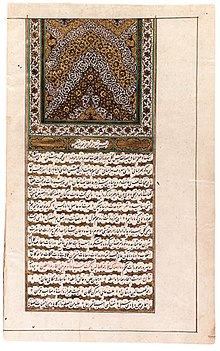
Mahmoud Shabestari or Mahmūd Shabestarī (Persian: محمود شبستری; 1288–1340) is one of the most celebrated Persian Sufi poets of the 14th century.
Life and work

Shabistari was born in the town of Shabestar near Tabriz in 1288 (687 AH), where he received his education. He became deeply versed in the symbolic terminology of Ibn Arabi. He wrote during a period of Mongol invasions.
His most famous work is a mystic text called The Secret Rose Garden (Gulshan-i Rāz) written about 1311 in rhyming couplets (Mathnawi). This poem was written in response to fifteen queries concerning Sufi metaphysics posed to "the Sufi literati of Tabriz" by Rukh Al Din Amir Husayn Harawi (d. 1318). It was also the main reference used by François Bernier when explaining Sufism to his European friends (in: Lettre sur le Quietisme des Indes; 1688)
Other works include The Book of Felicity (Sa'adat-nāma) and The Truth of Certainty about the Knowledge of the Lord of the Worlds (Ḥaqq al-yaqīn fi ma'rifat rabb al-'alamīn. The former is regarded as a relatively unknown poetic masterpiece written in khafif meter, while the latter is his lone work of prose.
See also
Notes
- Leonard Lewisohn, C. Shackle, "ʻAṭṭār and the Persian Sufi tradition: the art of spiritual flight", I.B. Tauris, 2006. p. 40
- Jon Robertson, "Fire and light: an off-road search for the spirit of God", Celestial Arts, 2006. p. 206: "The great thirteenth-century Persian Sufi poet Mahmud Shabistari"
- Gai Eaton, "Islam and the destiny of man", SUNY Press, 1985. p. 53: "According to the Persian poet Mahmud Shabistari: "The Absolute is so nakedly apparent to man's sight that it is not visible"
- Lewisohn (1995) p. 8
- Lewisohn (1995) p. 1
- Lewisohn (1995) p. 21
- Lewisohn (1995) p. 24/39
References
- Leonard Lewisohn, Beyond Faith and Infidelity. Cruzon Press. 1995 ISBN 0-7007-0343-8
- E.G. Browne, Literary History of Persia. (Four volumes, 2,256 pages, and twenty-five years in the writing). 1998. ISBN 0-7007-0406-X
- Jan Rypka, History of Iranian Literature. Reidel Publishing Company. 1968 OCLC 460598. ISBN 90-277-0143-1
- François Bernier, Lettre sur le Quiétisme des Indes in: Histoire des Ouvrages des Savans, Henri Basnage de Beauval (ed.), September 1688.
- de Bruijn, J.T.P. (1991). "Maḥmūd B. ʿAbd al-Karīm b. Yaḥyā S̲h̲abistarī". In Bosworth, C. E.; van Donzel, E. & Pellat, Ch. (eds.). The Encyclopaedia of Islam, Second Edition. Volume VI: Mahk–Mid. Leiden: E. J. Brill. pp. 72–73. ISBN 978-90-04-08112-3.
- Lewisohn, Leonard (2019). "Sufism in Late Mongol and Early Timurid Persia, from 'Ala' al-Dawla Simnānī (d. 736/1326) to Shāh Qāsim Anvār (d. 837/1434)". In Babaie, Sussan (ed.). Iran After the Mongols. Bloomsbury Publishing. pp. 177–211. ISBN 978-1788315289.
External links
- www.poetry-chaikhana.com
- www.phanes.com
- www.poetseers.org
- Works by or about Mahmoud Shabestari at the Internet Archive
- Works by Mahmoud Shabestari at LibriVox (public domain audiobooks)
